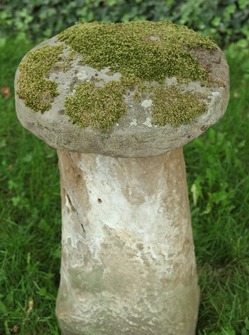 Staddle stones take their name from the Old English stathol which means a support or the trunk of a tree. These nifty little pedestals that seem to defy the laws of physics have been used for hundreds of years as the elevating bases for granaries, beehives, game larders, hayricks, and even small barns – any outbuilding that might warehouse things prone to attracting pests. Staddle stones occasionally appear in other places, but are most common in England and in parts of Spain.
Staddle stones take their name from the Old English stathol which means a support or the trunk of a tree. These nifty little pedestals that seem to defy the laws of physics have been used for hundreds of years as the elevating bases for granaries, beehives, game larders, hayricks, and even small barns – any outbuilding that might warehouse things prone to attracting pests. Staddle stones occasionally appear in other places, but are most common in England and in parts of Spain.
Early staddles were made of wood, but stone proved to be not only far more durable but also more stable when it came to holding up under the weight of the finished structure. (While stone is the most obvious choice, there are a few extant examples of cast iron staddles.) The stones themselves were made from whatever was available and thus appear in a variety of sandstone and granite, as well as other stone. Interestingly, the design of the stones varies regionally, both the base and the top, with the bases ranging from cylindrical to triangular to rectangular with varying degrees of tapering and the tops also exhibiting regional variations and even designs.
The key requirement is that the top is flat enough to support the corner of the structure soundly while also overlapping the base stone in a “mushroom cap” far enough to make a “squirrel baffle” of sorts, preventing any climbing rodent from making the transition from the base to the side of the structure and the hay or grain it contained. Elevation has the added advantage of increasing air circulation and preventing the damaging effects of moisture. If such buildings required steps, either a more temporary and portable option, such as a section of log, was used or the top step was simply omitted, assuring a gap large enough to deter rodents was still present.
For collectors, evidence of the stone’s age and wear consistent with a long-time connection between the base and the top are key to value (perhaps because they are also key to detecting fakes). Staddle stones with good age (collectors even like to see evidence of moss or lichen) can easily fetch several hundred or even a thousand dollars.


![Pottery; San Ildefonso, Blackware, Bowl, Martinez (Maria), Avanyu Decoration, 10 inch. Maria Martinez San Ildefonso blackware [pottery] bowl, vasiform with high rounded shoulder gunmetal finish with [decoration of] Avanyu slithering along shoulder; signed Marie on base, circa 1925.](http://www.prices4antiques.com/item_images/medium/64/26/10-01.jpg)
![Document Signed; Jefferson (Thomas) & Madison (James), 1803, Ohio Land Grant. Thomas Jefferson [autograph/autographed] signed land grant, document signed, partially printed on vellum, May 2, 1803, signed by Thomas Jefferson as President (1801 to 1809) and James Madison as Secretary of State (President, 1809 to 1817).](http://www.prices4antiques.com/item_images/medium/53/62/19-01.jpg)



